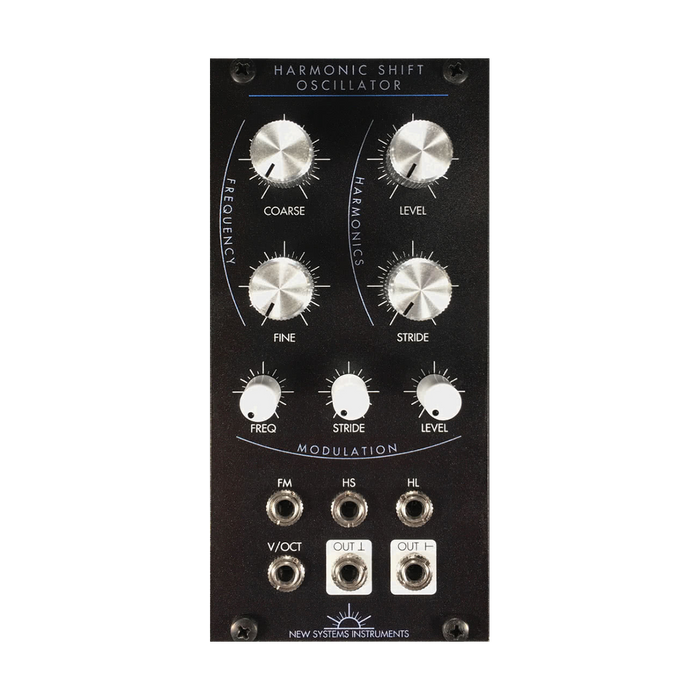
New Systems Instruments Harmonic Shift Oscillator
Format: Eurorack
Width: 12HP
Depth: 25mm
Current: 80mA @ + 12V, 75mA @ -12V
Manual pdf (English)

Format: Eurorack
Width: 12HP
Depth: 25mm
Current: 80mA @ + 12V, 75mA @ -12V
Manual pdf (English)
Harmonic Shift Oscillator (HSO)Overtone components including dissonant frequenciesIs an additive synthesis type full analog oscillator that can be directly controlled with a knob or CV.Although it has a very simple structure with three controls, it can produce a wide range of tones such as bass, unstable reeds, fading, dissonance, and bell-like sounds.It also achieves high quality in FM, and has high potential as a percussion sound source by combining it with other modulations.
When the waveform of a constant continuous sound such as an oscillator is decomposed for each frequency, there is generally a sine wave of the fundamental tone with a frequency corresponding to the pitch, and various sine waves called overtones are superimposed on it. It becomes a tone.The overtones of a sound from an ordinary unmodulated oscillator usually consist only of integral multiples of the fundamental.For example, a square wave can be created by mixing only odd-numbered overtones with a fundamental tone at a fixed rate.
In contrast to the conventional subtractive synthesis that removes overtones from sawtooth waves and square waves, the method of creating timbres by changing the composition of overtones in this way.Additive synthesisIt may be called. HSO is also an oscillator of this additive synthesis type, but the feature of HSO is that not only the overtones of integer multiples but also the overtones between integers can be continuously selected, so the range of sounds to be realized becomes wider.Dissonance or bell-like soundCan be easily created.
In HSO, the frequency control Coarse knob and Fine knob are located on the left side of the panel, and CV control is possible with the FM jack with attenuator and 1V / Oct. HSO is characterized by two on the right, Level and Stride, which control the overtone composition.
Level (L)Controls the relative proportion of overtones included, and turning it to the right increases the number of overtones, leaving only the sine wave of the fundamental tone when it is full to the left. This is an image that controls the intensity (brightness) of the tone determined by S.
Stride (S)Is a parameter that characterizes the frequency distribution that makes up the overtones, and has a great effect on the timbre.The knob is in the middle and S = 1, which includes all integer harmonics.If you turn it to the right, S = 2 in the middle, and at this time, only odd harmonics will be included, and the frequency that composes the square wave will be the same as described above.However, the proportion of each overtone specified by L in HSO does not match the overtone ratio of the square wave, and in general, HSO has more (brighter) higher harmonics than the square wave.In the case of S, which is not an integer, the overtone frequency is no longer an integral multiple of the fundamental frequency, resulting in a dissonant sound.For example, a bell-like sound is a mixture of wide-interval and dissonant high frequencies, so turn S to the right to create it.
As you turn S, fading occurs due to subtle frequency differences around the harmonics that are in harmony with the fundamental.The longest fading cycle has the highest frequency reconciliation.
The output is the same signal that is 90 degrees out of phase with each other, which is useful for stereo processing and mixing after different processes.
?